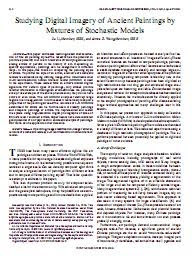 Title: Digital Imagery for Significant Cultural and Historical Materials - An Emerging Research Field Bridging People, Culture, and Technologies
Title: Digital Imagery for Significant Cultural and Historical Materials - An Emerging Research Field Bridging People, Culture, and TechnologiesAuthor: Ching-chih Chen, Howard Wactlar, James Z. Wang and Kevin Kiernan
Reference: International Journal on Digital Libraries,Special Issue: Towards the New Generation Digital Libraries: Recommendations of the US-NSF/EU-DELOS Working Groups, vol. 5, no. 4, pp. 275-286, 2005
Link: http://stanford.edu/... (PDF, 461 Kb)
Abstract:
Digital imagery for significant cultural and historical materials is an emerging research field that bridges people, culture, and technologies. In this paper, we first discuss the great importance of this field. Then we focus on its four interrelated sub-areas: (1) creation and preservation, (2) retrieval, (3) presentation and usability, and (4) applications and use. We propose several mechanisms to encourage collaboration. We argue that the research has high potential impact to our digital society. Finally, we make specific recommendations on what to pursue in this field.


















